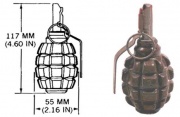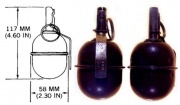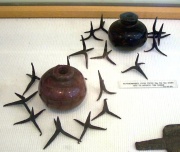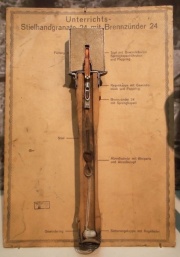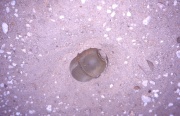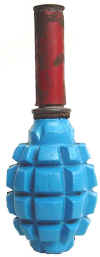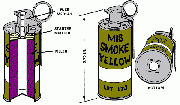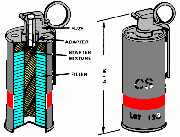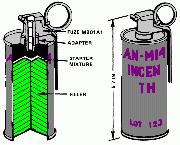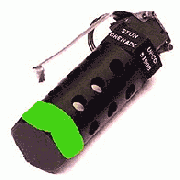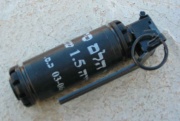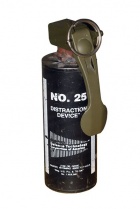Hand grenade
A hand grenade is a small hand-held anti-personnel weapon designed to be thrown and then explode after a short time. The word "grenade" is derived from the French grenade, meaning pomegranate, so named because its shrapnel pellets reminded soldiers of the seeds of this fruit. Grenadiers were originally soldiers who specialized in throwing grenades.
Not all grenades are thrown by hand. Several types are fired from rifles or purpose-designed grenade launchers. For example, tear gas grenades used in riot control are fired from riot guns, and the M203 grenade launcher can be fitted to several types of assault rifles.
Contents |
History

The first grenades appeared in the Byzantine Empire, not long after the reign of Leo III (717-741).[2] Byzantine soldiers learnt that Greek fire, a Byzantine invention of the previous century, could not only be thrown by flamethrowers at the enemy, but also in stone and ceramic jars.[2] Later, also glass containers were employed. Byzantine made hand grenades with Greek fire in the 10th to 12th centuries are at display in the National Museum at Athens. The use of Greek fire, or rather variants thereof, spread to Muslim armies in the Near East, from where it reached China by the 10th century.[2]
In China during the Song Dynasty (960–1279AD), known as Zhen Tian Lei when Chinese soldiers packed gunpowder into ceramic and/or metal containers. In 1044, a military book Wujing Zongyao ("Compilation of Military Classics") described various gunpowder recipes in which one can find, according to Joseph Needham, the prototype of the modern hand grenade.[3]
The first cast iron bomb-shells and grenades seen in China did not appear in Europe until 1467.[4] Within a couple centuries of this, the Chinese had discovered the explosive potential of packing hollowed cannonball shells with gunpowder. Written later by Jiao Yu in the mid 14th century book of the Huolongjing ("Fire Drake Manual"), this manuscript recorded an earlier Song-era cast iron cannon known as the 'flying-cloud thunderclap eruptor' (fei yun pi-li pao). The manuscript stated that (Wade-Giles spelling):
The shells (phao) are made of cast iron, as large as a bowl and shaped like a ball. Inside they contain half a pound of 'magic' gunpowder (shen huo). They are sent flying towards the enemy camp from an eruptor (mu phao); and when they get there a sound like a thunder-clap is heard, and flashes of light appear. If ten of these shells are fired successfully into the enemy camp, the whole place will be set ablaze...[5]
This text of the Huolongjing was also important for the understanding of the Chinese hand grenade in the 14th century, as it provided much more detailed descriptions and even printed illustrations of the grenade bombs used.[6]
In 1643 it is possible that 'Grenados' were 'thrown amongst the Welsh' at Holt Bridge during the English Civil War.
The use of the word 'grenade' in the English language apparently originated in the Glorious Revolution (1688), where cricket ball-sized iron spheres packed with gunpowder and fitted with slow-burning wicks were first used against the Jacobites in the battles of Killiecrankie and Glen Shiel.[7]
These grenades were not very effective (probably because a direct hit would be necessary for the grenade to have effect) and, as a result, they saw little use.
However, trench warfare favored the grenade. In a letter to his sister, Colonel Hugh Robert Hibbert, described an improvised grenade employed during the Crimea War (1854-1856):
- We have a new invention to annoy our friends in their pits. It consists in filling empty soda water bottles full of powder, old twisted nails and any other sharp or cutting thing we can find at the time, sticking a bit of tow in for a fuse then lighting it and throwing it quickly into our neighbours pit where it bursts, to their great annoyance. You may imagine their rage at seeing a soda water bottle come tumbling into a hole full of men with a little fuse burning away as proud as a real shell exploding and burying itself into soft parts of the flesh.[8]
In the American Civil War, both sides used crude hand grenades equipped with a plunger that would detonate the device upon impact of the target. The North relied on experimental Ketchum Grenades, with a tail to ensure the nose would strike the target and start the fuse. The Confederacy used spherical hand grenades that weighed about six pounds, sometimes with a paper fuse. They also used Rains and Adams grenades, which were similar to the Ketchum in appearance and mechanism.
One of the first, if not the first, widely used percussion hand grenades was designed about 1903~1904 by a collonel of Serbian army, Miloš Vasić. In 1912, colonel Vasić further redesigned his hand grenade into "Vasić" M.12 model. They were adopted by Serbian army in 1912, just in time to be used in 1st and 2nd Balkan war (1912-1913) and extensively used by Serbian infantry in World War I[2]. That grenade was popular under name of "Vasićka" (by it's designers name), or "Kragujevka" (by it's place of manufacture, the military-technical works in Kragujevac, Serbia). Vasić design was further developed into series of new hand grenades which lasted until far after the end of World War II.[3] The most infamous usage of "Vasić" hand-grenade was in the assasination of archiduke Franz Ferdinand, in Sarajevo in 1914, when one of the involved threw one "Vasić" grenade at the archduke's car. The grenade bounced off the target and exploded under the following vehicle, wounding about 20 people. Franz Ferdinand and his wife were shot to death later that day. Austro-Hungarian authorities confiscated a couple of "Vasić" grenades from assassins, and used them to support their accusations to Serbia for the alleged participation in assassination plot, the act that led to the outbreak of WWI.
In World War I (1914-1918) both sides only had small pre-war stocks of grenades. As an interim measure, the troops often improvised their own, such as the Jam Tin Grenade. These were replaced when manufactured versions such as the Mills bomb, the first modern fragmentation grenade, became available to British front-line troops. The Mills bomb was developed at the Mills Munitions Factory in Birmingham, England and was described as the first 'safe grenade'. 75,000,000 grenades were made during World War I. It was an explosive-filled steel canister with a triggering pin and a distinctive deeply notched surface. This segmentation was thought to aid fragmentation and therefore increase the grenade's deadliness. Later research showed that the segmentation did not improve fragmentation in any way at all. Improved-fragmentation designs would later be made with the notches on the inside, but at the time, this would have been too expensive to produce. The external segmentation of the original Mills bomb was retained, since it did provide a positive grip surface. This basic "pin-and-pineapple" design is still used in some modern grenades. On the other hand, the U.S. M67 fragmentation grenade has a smooth exterior, which is much more suitable for being rolled into a room or being thrown in a flat arc like a baseball.
To propel grenades farther, the rifle grenade was devised. This made use of a modified rifle with a blank cartridge to propel the grenade. These rifles would often be permanently fixed in wooden support frames and would not be used for firing bullets. Use was also made of catapults, both manufactured and improvised, although these were eventually replaced in the trenches by small mortars.
Parallel to the Mills bomb and its similar counterparts, the Germans issued the "stick hand grenade" (Stielhandgranate) which featured an explosive charge encased in a metal can and mounted on a wooden shaft for throwing. This simple design continued to evolve throughout the First and Second World Wars, with the Model 24 grenade (popularly known as the "potato masher") becoming one of the most easily recognized of all small arms, and synonymous with the German soldier.
The Molotov cocktail is an improvised grenade prepared from a glass bottle filled with alcohol (ethanol) or gasoline (petrol) ignited by a burning strip of cloth when the thrown bottle bursts against its target. The Molotov cocktail received its name during the 1939 Winter War, but had been in use earlier in the decade. The name originated from Finnish troops during the Winter War. It was named after former Soviet foreign minister Vyacheslav Molotov whom they deemed responsible for the war, and a black-humorous reference to the Soviet bombs known as "Molotov bread baskets" in Finland.
Design
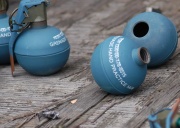
Grenades come in different sizes and shapes, for different purposes. Most are designed to explode, projecting shrapnel, i.e., sharp pieces of the casing, serrated wire, or an incendiary material. Some, like smoke grenades, merely burn, releasing colored smoke for masking, marking, or signaling. All grenades have two things in common: first, they are hollow so they can be filled with the explosive or chemical filler; and second, they contain a hole into which a fuse can be screwed or inserted.
A grenade is essentially a small bomb, and works very much like a simple firecracker. A firecracker is made up of a paper body filled with flash powder and fitted with a small fuse. Once lit, the fuse burns down to the powder and blows the paper body apart. In modern hand grenades, the fuse is lit by an internal device rather than an external flame.
Characteristics
Hand grenades have four characteristics:
- Their employment range is short
- Their effective casualty radius is small
- Their delay element permits safe throwing;
- Their hard shell enables grenades to ricochet off hard surfaces, like walls, before detonating.
Hand grenades have the following main parts:
- The body contains the filler, and in some grenades provides the fragmentation
- The filler is the chemical or explosive substance in the grenade, which determines the grenade's use and characteristics
- The fuse assembly causes the grenade to function by igniting or detonating the filler

Using grenades
A classic hand grenade has a safety handle or lever (sometimes called the "spoon") and a removable safety pin that prevents the handle from being released. Some grenade types also have a safety clip to further prevent the handle from coming off in transit.
To use a grenade the soldier grips it firmly with his/her throwing hand, ensuring that the safety lever is firmly held in place with the thumb. This is called the 'death grip' by many soldiers, because letting the lever go could (and probably will) cause the grenade to detonate, killing the thrower. Left-handed soldiers are advised to invert the grenade, ensuring that the thumb is still the digit holding the safety lever in place. The pull ring of the safety pin is then grasped with the index or middle finger of the non-throwing hand and the safety pin is removed using a pulling and twisting motion. The grenade is then thrown towards the target, an over-arm throw is recommended but may not be suitable for an actual combat situation. Soldiers are trained to throw grenades in standing, prone-to-standing, kneeling, prone-to-kneeling, and alternate prone positions and in under- or side-arm throws. If the grenade is thrown from a standing position the thrower must then immediately seek cover or lie prone if no cover is nearby.
Once the grenade is thrown the safety lever is released and the striker throws the safety lever away from the grenade body as it rotates to detonate the primer. The primer explodes and ignites the fuse (sometimes called the delay element), the fuse burns down and activates the detonator which explodes the main charge.
When using an antipersonnel grenade, the objective is to have the grenade explode so that the target is within its effective radius. For the M67 fragmentation grenade used by several NATO nations, the effective kill zone has a five meter radius, while the casualty-inducing radius is approximately fifteen meters.[9] Fragments can fly as far as 230 meters.
"Cooking off" is a term referring to intentionally holding onto an armed grenade after the pin has been pulled and the handle released, to decrease the amount of time to detonation after throwing. This technique is used to reduce the ability of the enemy to take cover or throw the grenade back. It is also used to allow the grenade to burst in the air over defensive positions.[10] This technique is inherently dangerous, since fuses may vary from grenade to grenade. Because of this the U.S. Marines (MCWP 3-35) describe cooking-off as the "least preferred technique", recommending a "hard throw, skip/bounce technique" to prevent an enemy returning a grenade.
A call is usually given upon deploying a grenade, to warn friendly forces. Some yells, such as "grenade" or "fire in the hole" are used when a grenade has been thrown in by an enemy; in any instance the purpose is to warn fellow soldiers to take cover.
In the U.S. Military, when a grenade is dropped into an enclosed space like a tunnel, room, or trench, the person dropping the grenade should yell "fire in the hole" to warn that an explosion is about to occur. Other U.S. military procedures include calling "frag out" to indicate that a fragmentation grenade has been deployed.
Grenades are often used in the field to construct booby traps, using some action of the intended target (such as opening a door, or starting a car) to trigger the grenade. These grenade-based booby traps are simple to construct in the field using readily available materials. The most basic technique involves wedging a grenade in a tight spot so the safety lever does not leave the grenade when the pin is pulled. A string is then tied from the head assembly to another stationary object. When a soldier steps on the string, the grenade is pulled out of the narrow passageway, the safety lever is released, and the grenade detonates.
Abandoned booby traps and discarded grenades contribute to the problem of unexploded ordnance. The use of trip wire-triggered grenades (along with land mines in general) is banned under the Ottawa Treaty and may be treated as a war crime wherever it is ratified.
The People's Republic of China, the United States, and Russia have not signed the treaty despite international pressure, citing self-defense needs.
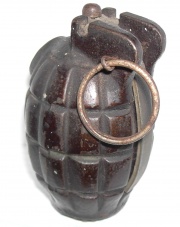
Grenades have also been made to release smoke, tear gas and other gases, as well as illumination. Special forces often use stun grenades to disorient people during entry into a room.
Some grenade designs were made to be thrown longer distances. The German "potato-masher" grenade had a long wooden handle that extended its range by fifty percent. The "potato-masher" was fired by a friction igniter in the head, which was activated by a pull string threaded through the hollow handle. Immediately before throwing the grenade, the soldier pulled a small porcelain ball attached to a string attached to the friction igniter. This started the time fuse which fired the detonator after a delay. The "potato-masher" is often incorrectly thought to have had an impact fuse. It did not, but the superficially similar British stick grenade design of 1908 did.
Types of hand grenades
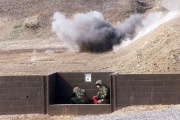
Fragmentation grenades
The fragmentation grenade (commonly known as a "frag") is an anti-personnel weapon that is designed to disperse shrapnel upon exploding. The body is made of hard plastic or steel. Flechettes, notched wire, ball bearings or the case itself provide the fragments. When the word "grenade" is used without specification, and context does not suggest otherwise, it is generally assumed to refer to a fragmentation grenade.
These grenades were sometimes classed as defensive grenades because the effective casualty radius of some matched or exceeded the distance they could be thrown, thus necessitating them being thrown from behind cover. The Mills bomb or F1 grenade are examples of defensive grenades where the 30–45 m casualty radius[11] matched or exceeded the 30 m that a grenade could reasonably be thrown.
Modern fragmentation grenades such as the United States M67 grenade have a wounding radius of 15 m (half that of older style grenades which may still be encountered) and can be thrown about 40 m. Fragments may travel more than 200 m.[12]
Concussion grenades
The concussion grenade is an anti-personnel device that is designed to damage its target with explosive power alone. Compared to fragmentation grenades, the explosive filler is usually of a greater weight and volume. The case is far thinner and is designed to fragment as little as possible. The overpressure produced by this grenade when used in enclosed areas is greater than that produced by the fragmentation grenade. Therefore, it is especially effective in enclosed areas.
These grenades are usually classed as offensive weapons because the effective casualty radius is smaller than the distance it can be thrown.
The US MK3A2 concussion grenade is filled with TNT and has a body made of tarred cardboard.
The term 'concussion' is often erroneously applied to stun grenades. This is not descriptive of the effects caused by the grenade. The term 'concussion' is used because the grenade relies on its explosive power to create casualties.
Percussion grenades
A percussion grenade detonates upon impact with the target. Classic examples of percussion grenades are the British Gammon bomb and No. 69 grenade. Timed fuse grenades are generally preferred to hand-thrown percussion grenades because their fuzing mechanisms are safer and more robust than those used in percussion grenades. Some percussion grenades have a conventional pyrotechnic fuse fitted as a backup detonation device.
Smoke grenades
- Main article: Smoke grenade
Smoke grenades are used as ground-to-ground or ground-to-air signaling devices, target or landing zone marking devices, and screening devices for unit movement. The body is a sheet-steel cylinder with emission holes in the top and bottom. These allow the smoke to be released when the grenade is ignited. Two main types exist, colored smoke (for signaling) and screening smoke. In colored smoke grenades, the filler consists of 250 to 350 grams of colored smoke mixture (mostly potassium chlorate, lactose and a dye). Screening smoke grenades usually contains HC (hexachloroethane/zinc) smoke mixture or TA (terephthalic acid) smoke mixture. HC smoke is harmful to breathe, since it contains hydrochloric acid. Whilst not intended as a primary effect, these grenades can generate enough heat to scald or burn unprotected skin and the spent casing should not be touched until it has cooled.
Riot control
Contrary to popular belief, gas-expelling grenades are rarely used to disperse large groups, because of the risk of causing generalized panic. Grenades are instead used to create barriers of tear gas in order to direct the movement of large groups of people, or to protect police officers on the verge of being overwhelmed. As an exception, tear gas may be used to disperse a mob surrounding a small centralized group.
Similarly, gas-expelling grenades are not often used to force criminals out of cover because of the risk of intoxicating people in enclosed areas, although SWAT teams will occasionally employ CS gas grenades to facilitate the arrest of an armed suspect, especially if there are no bystanders in the area. This kind of deployment is most often used in an area where several suspects have a large amount of cover, since the functioning of other distraction grenades will be hindered.
Tear gas grenades are similar to smoke grenades in terms of shape and operation. In tear gas grenades the filler is generally 80 to 120 grams of CS gas combined with a pyrotechnic composition which burns to generate an aerosol of CS-laden smoke. This causes extreme irritation to the eyes and, if inhaled, to the nose and throat. Occasionally CR gas is used instead of CS.
Incendiary grenades
Incendiary grenades produce intense heat by means of a chemical reaction. The body is practically the same as that of a smoke grenade. The filler is 600 to 800 grams of thermate, which is an improved version of World War II-era thermite. The chemical reaction that produces the heat is called a "thermite reaction". In this reaction, powdered aluminium metal and iron oxide react to produce a stream of molten iron and aluminium oxide. This reaction produces a tremendous amount of heat, burning at 2200 °C (4000 °F). This makes incendiary grenades useful for destroying weapons caches, artillery, and vehicles. Other advantages include its ability to function without an external oxygen source, allowing it to burn underwater. Because they are not intended to be thrown, thermate incendiary grenades generally have a shorter delay fuse than other grenades e.g. two seconds.
White phosphorus (also used in smoke grenades; see above) can also be used as an incendiary agent. It burns at a temperature of 2800 °C (5000 °F).
Thermite and white phosphorus cause some of the worst and most painful burn injuries because they burn so quickly and at such a high temperature. In addition, white phosphorus is very poisonous: a dose of 50-100 milligrams is lethal to the average human.
A common improvised incendiary grenade is the Molotov Cocktail.
Stun grenades
Invented by the SAS in the 60's, the term stun grenade, while in widespread use in games and the media, is actually a misnomer; the typical "flashbang" (or "bang") deployed by a civilian law enforcement tactical team in the US is technically not a grenade. There are numerous mechanical and end-use differences between an NFDD (noise flash diversionary device) and a stun grenade (or in fact a grenade of any type). Most professional organizations dealing in SWAT/police special operations take great pains to teach their officers to differentiate between an NFDD and a true grenade. This is largely due to frequently spurious lawsuits but also admittedly to avoid the negative connotation of the term "grenade". The first devices of this type were created at the behest of the British Special Air Service as an incapacitant. Stun grenades are used to confuse, disorient, or distract a potential threat. A stun grenade can seriously degrade the combat effectiveness of affected personnel for up to a minute. The best known example is the M84 Stun Grenade, which produces a blinding (6-8 million Candela) flash and deafening (170-180 dB SPL) blast. This grenade can be used to incapacitate people, generally without causing serious injury. Standing operating procedure for LAPD SWAT has officers deploy flashbangs close to the point of entry. This is because all attention will be directed towards the door once it has been breached, and deploying the flashbang close to this point heightens the chances that a suspect will be affected by the device.
The flash of light momentarily activates all photosensitive cells in the retina, making vision impossible for approximately five seconds until the eye restores the retina to its original, unstimulated state. Subjects affected by flashbangs describe seeing a single frame for the five seconds (as if their vision was "paused") until it fades and normal sight returns (most modern video games include this effect.). This is because the sensory cells which have been activated continue sending the same information to the brain until they are restored to their resting state, and the brain translates this continuous information into the same image. The incredibly loud blast emitted by the grenade contributes to its incapacitating properties by disturbing the fluid in the semicircular canals of the ear.
When detonated, the fuse/grenade body assembly remains intact and produces no fragmentation. The body is a steel hexagonal tube with holes along the sides which allow a blast of light and sound to be emitted. This is done to prevent injury from shrapnel but it is still possible to receive a burn, and injuries resulting from the concussive properties of the detonation sometimes occur, the intense heat created by the flashbang can also ignite flammable materials such as fuel or certain fabrics. The fires that occurred during the Iranian Embassy Siege in London were caused by stun grenades. The filler consists of about 4.5 grams of a pyrotechnic metal-oxidant mix of magnesium or aluminum and an oxidizer such as ammonium perchlorate or potassium perchlorate. Sparklers usually contain these materials in proper mixture and can be used as improvised or recreational stun grenades.
Sting grenades
Sting grenades are based on the design of the fragmentation grenade. Instead of using a metal casing to produce shrapnel, they are made using two spheres of hard rubber. Inside the smaller sphere is the explosive charge, primer, and detonator. The space between the two spheres is then filled with many small, hard rubber balls. Upon detonation, the subject is incapacitated by the blunt force of the projectiles. The advantage to using sting grenades comes from the fact that the subject is very often incapacitated, winded, or at the very least dislodged from cover.
Some types, such as the ALSG101CS from ALS Technologies, have an additional payload of chemical agents like CS gas.
The advantages compared to a flashbang are
- The "plug 'n shut" tactic, in which one's eyes are shut and ears are plugged to avoid the effects of a flashbang. This does not protect a person from a sting grenade.
- The subject does not need to be looking at the grenade for it to take full effect.
- Sting grenades are much more likely to cause a subject to either fall or lower himself in pain, thus providing good sight lines to unaffected targets in the area.
This makes sting grenades ideal for containing small groups of rowdy prisoners, providing a shooting opportunity when a suspect is hiding behind cover, or in allowing SWAT teams to clear small rooms.
A disadvantage of using sting grenades is that they are not sure to incapacitate a subject, so they are dangerous to use with armed subjects. This is because sting grenades rely on the body's reaction to adverse stimuli (pain and blunt force trauma) rather than denial of sensory input. A person with sufficient mental focus can concentrate enough to ignore being hit by a sting grenade's payload, whereas a stun grenade will physically affect vision and sense of orientation. The effective range of a sting grenade is limited compared to a stun grenade. In addition, there is the risk of serious physical injury as the target is being pelted with actual objects capable of inflicting harm, and not just being deafened/blinded.
Impact stun grenades
A more recent development is the Blank Firing Grenade (BFIG or Blank Firing Impact Grenade). Preferred in many situations, especially training, for two main reasons; they are re-usable - and therefore more economical - because the charge is a standard ammunition blank, and they are subject to very few transport restrictions when unloaded. The BFIG contains a mechanism to fire a blank cartridge when dropped at any angle onto a hard surface from a height of a metre or more. Firing will occur in any combination of positions only on impact. [4]
Anti-tank grenades
The first anti-tank grenades were improvised devices usually made by putting a number of fragmentation grenades into a sandbag or by tying them together. Due to their weight, these were normally thrown from very close range or directly placed in vulnerable spots onto an enemy vehicle.
Purpose-designed anti-tank grenades invariably use the shaped charge principle to penetrate the tank's armor. This means that the grenade has to hit the vehicle at an exact right angle for the effect to work properly. This is achieved by the grenade deploying a small drogue parachute or fabric streamers after being thrown.
Britain put the first anti-tank grenade into the field during the Second World War with the rifle-fired No 68 AT Grenade. Also developed by the UK during the war, was the No 74 ST Grenade popularly known as a sticky bomb; the main charge was held in a sphere covered in adhesive. In anticipation of a German invasion, it was produced in substantial numbers. Inherently dangerous for the user, it was relegated to Home Guard use.
During World War II, when tanks overran entrenchments, anti-tank mines could be and were used by infantry as an improvised hand grenades by placing or throwing them in the path of a tank in the hope of disabling a track.
The most widely-distributed anti-tank grenades are the Russian designs of the 1950s and later, mainly the RKG-3.
Due to improvements in modern tank armor, anti-tank hand grenades are generally considered obsolete. However in recent conflict, namely the Iraq War, the RKG-3 anti-tank hand grenade has made a reappearance in the service of insurgents who utilize them primarily against US Humvees, which lack the heavier armor of tanks. [13]
Grenades as ornamentation
Stylized pictures of early grenades, emitting a flame, are used as ornaments on military uniforms, particularly in France (esp. French Gendarmerie and the French Foreign Legion), and Italy (Carabinieri). Fusilier regiments in the British and Commonwealth tradition (e.g. the Princess Louise Fusiliers, Canadian Army) wear a "flaming grenade" cap-badge, reflecting their historic use of grenades in the assault. The British Grenadier Guards took their name and cap badge of a burning grenade from repelling an attack of French Grenadiers at Waterloo. The flag of the Russian Ground Forces also bears a "flaming grenade" device. The branch insignia of the US Army Ordnance Corps also uses this symbol, the grenade being symbolic of explosive ordnance in general. The United States Marine Corps also uses the grenade on their uniforms: the rank insignia for master gunnery sergeant has three chevrons pointing up, with four rockers on the bottom. In the middle of this is a bursting bomb, or grenade. US Navy Aviation Ordnanceman's rating badge features a winged device of similar design. Ukrainian Mechanized Infantry and Engineers use a "flaming grenade" in their branch insignia.
See also
- Nils Waltersen Aasen, the creator of the modern hand grenade
- Rocket propelled grenade
- Rifle grenade
- Grenade launcher
References
- ↑ "The Genius of China", Robert Temple
- ↑ 2.0 2.1 2.2 Robert James Forbes: “Studies in Ancient Technology”, Leiden 1993, ISBN 9789004006218, p.107
- ↑ Joseph Needham: Science and civilization in China: Vol. 5; Part 6: Chemistry and chemical technology; Military technology: missiles and sieges, Cambridge University Press 1994, ISBN 0-521-32727-X
- ↑ Needham, Volume 5, Part 7, 179.
- ↑ Needham, Volume 5, 264.
- ↑ Needham, Volume 5, Part 7, 179-180.
- ↑ Cramb, Auslan (23 Feb 2004). "Battlefield gives up 1689 hand grenade". Scotland Correspondent.
- ↑ The National Archives, records of the UK government Letters of Hibbert, Hugh Robert, 1828-1895, Colonel, ref. DHB/57 - date: 14 Jun. 1855
- ↑ United States Army Field Manual 3-23.30, Grenades and Pyrotechnic Signals (2005 revision), page 1-6
- ↑ United States Army Field Manual 3-23.30, Grenades and Pyrotechnic Signals (2005 revision), pages 3-11 to 3-12
- ↑ (Ukrainian) [1]
- ↑ Federation of American Scientists. M67 FRAGMENTATION HAND GRENADE
- ↑ New Russian made armour-piercing grenade causing US casualties in Iraq
- Needham, Joseph (1986). Science and Civilization in China: Volume 5, Part 7. Taipei: Caves Books, Ltd.
External links
- RUAG - manufacturer of modern hand grenades
- Mecar - Belgian manufacturer of various grenade types
- Pakistan Ordnance Factories - licensed manufacturer of Arges grenades
- Film of exploding grenade - taken using ultra high-speed photographic technique (2/3 million frames per second)
- How Grenades Work - from HowStuffWorks
- Exploded view of a modern Arges 73 hand grenade
- 90th Infantry Division Preservation Group Article on authentic WW2 pineapple grenades
- Grenade information and facts
